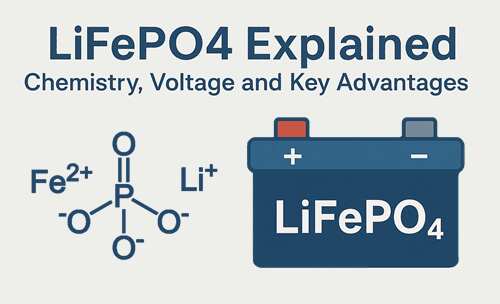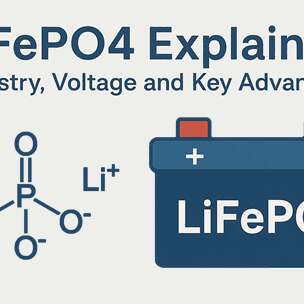LiFePO4 Explained: Chemistry, Voltage and Key Advantages
LiFePO4, short for lithium iron phosphate, is a lithium-ion cathode material that quietly transformed battery design over the last decade. If you want something robust, safe, and predictable for energy storage, RVs, solar systems or electric vehicles, this chemistry deserves attention. Below I unpack what it's, how its voltage behaves, and the practical advantages that make it a favorite.

Chemistry in plain terms
At the atomic level LiFePO4 has an olivine crystal structure. During charge and discharge cycles lithium ions shuttle between the cathode (LiFePO4) and the anode (commonly graphite). The iron and phosphate framework holds the structure tightly, which makes the material mechanically stable and less prone to breakdown under stress. That structural rigidity is a big reason LiFePO4 cells tolerate abuse better than many other lithium chemistries.
Voltage: what to expect
A single LiFePO4 cell has a nominal voltage of about 3.2 V. In practice:
- Typical charge limit: around
3.6 to 3.65 Vper cell. - Usable discharge window: most systems operate safely down to about
2.5 to 2.8 Vper cell, though exact cutoffs depend on the manufacturer and application. - The discharge curve is relatively flat, so voltage holds near nominal for a long portion of the cycle; this gives consistent performance until the cell approaches its lower limit.
Because cells are low voltage individually, battery packs usually connect many cells in series to reach higher pack voltages for specific applications.
Key advantages
- Safety and thermal stability: LiFePO4 is far less likely to experience thermal runaway, which means fewer fires and more predictable behavior under stress.
- Long cycle life: Expect several thousand cycles in well managed systems, often far more than lead acid or many other lithium types; that lowers lifetime cost.
- Consistent output: The flat voltage plateau gives steady power delivery, beneficial for inverters and electronics that prefer stable input.
- Good power density: While energy density (wh per kg) is lower than high energy NMC cells, LiFePO4 excels when power and longevity matter more than absolute weight.
- Environmental and chemical robustness: The iron and phosphate components are more abundant and less toxic than cobalt based chemistries, easing supply and recycling concerns.
Where LiFePO4 shines
This chemistry is common in stationary storage, off grid solar, marine, and many light electric vehicles. it's also popular as a direct replacement for lead acid batteries because it tolerates deeper discharge and delivers more cycles for comparable cost over the battery lifetime.
Quick practical notes
Balance charging and a proper battery management system (BMS) remain essential; they protect cells from over voltage, under voltage, and imbalance. When selecting LiFePO4, look beyond nominal capacity: examine cycle life claims, manufacturer datasheets for exact charge/discharge voltages, and whether a BMS is included. #LiFePO4 #LithiumIronPhosphate
LiFePO4 is not a one size fits all solution, yet for users seeking a safe, durable, and cost efficient battery chemistry, it's often the pragmatic choice. If you want help matching a LiFePO4 pack to a particular project or load profile, give me the specs and I’ll sketch out recommendations.

